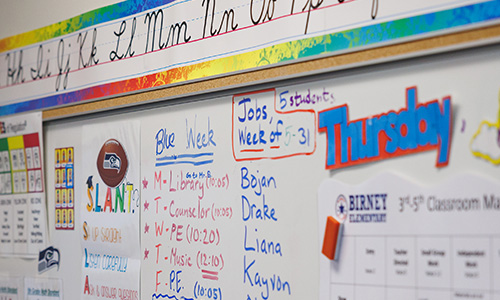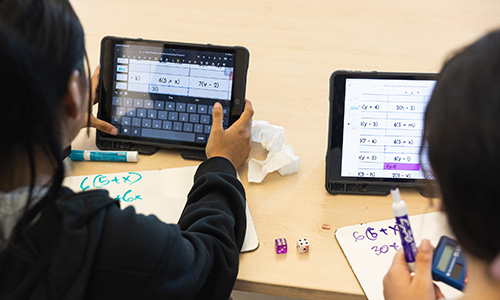
One of my daughter Kat’s favorite activities as a toddler was lining up a set of plastic bears that she would “borrow” from her older sister’s toys. They came in four different colors, and at first she enjoyed just putting them in a row. Later, she would make simple patterns as she arranged them in a snaking line. We have a video of her from when she was almost two years old saying the word “da” each time she pointed at a bear, moving her finger along the row, one by one. While she didn’t have the number words just yet, she was clearly developing the beginning procedures for counting. This video has remained a family favorite, admittedly less because of its wonderful depiction of early math skills and more because of how quickly Kat abandoned her counting when her sister walked in the room with a new doll. Apparently one new doll was larger in this toddler’s mind than twenty old bears!
I started thinking about all this after writing my previous post about the importance of early math skills. Many studiesindicate that the math skills that children have when they enter school are highly predictive of their math achievement beyond elementary school. Additionally, a recent review of the research literature found that 32 out of the 37 studies reviewed showed a positive association between home numeracy activities and children’s math skills.
All this got me thinking about how I encouraged math skills in my own children and what opportunities I might have missed. It also got me wondering where in her developmental trajectory Kat was when she was “counting” those bears. Luckily, there are many resources available to help parents and caregivers support early math development.
What young children know about math
When thinking about how to support children’s math development, it can be helpful to understand what they are potentially ready to learn at each stage. Although every child is different, you might be surprised to learn what research has shown children to be capable of doing and understanding at various ages. For example, several studiessuggest that children younger than a year old (and, in one study, as young as a few days old) can tell when the number of objects pictured changes from two to three or vice versa, indicating they have an innate sense of number. Another series of experiments suggests that even when they make mistakes counting, kids from three to five years of age may understand key concepts of counting, including one-to-one correspondence, the need to say the counting numbers in the correct sequence, and that the last number said represents the total counted.
So how do you know what your child might be ready to do without having to dig through all the research? Luckily there are resources that can help. Understood.org has a general overview of what children may know or understand starting at birth. Sesame Workshop has developed a matrix that shows what skills children may be learning at different stages in what have been identified as five key areas in early math development: number concepts and relations, number operations, geometry and spatial sense, measurement and comparison, and patterns. This matrix gives you a sense of the progression of skills in each area. Knowing this can help you know what concepts to explore next as your child shows understanding of previous concepts. This is important, as home math activities have been shown to be most effective when you stretch your child’s thinking.
Math is everywhere
Incorporating math into your child’s life is simpler than you may think. You don’t need special materials; the things and places you interact with daily provide all the stimulus needed to engage in rich math conversations and help your child develop early math skills. When my girls were young, I would often highlight when they used math in real life by enthusiastically singing, “That was math!” You can imagine how much my girls loved this. Thankfully Gigliana Melzi, a professor and researcher at NYU, has identified four steps for getting your kids involved in math at home that are more effective, and potentially less annoying, than my approach:
- Step 1: Uncover the math. When we think about math as adults, we may think of algebra or a complex set of procedures. It’s easy to miss everyday opportunities to explore foundational math concepts. Putting away laundry? That involves sorting objects by attributes. Cooking dinner? There’s lots of measurement going on there. Checking out at the supermarket? Deciding which line to get in can involve both counting and magnitude estimation (is it better to get in a line with five people with only a few items each or three people who each have a larger number of items?).
- Step 2: Involve your child in the math. When we do some of the activities listed above, we may not think to include our children. Bringing them into these activities helps them develop their early math skills and see math as a useful tool in everyday life. Plus, you get help folding the laundry!
- Step 3: Talk about the math. Math talk can take several forms. You can model your own thinking as you walk through a task. For example, when shopping, you can talk through figuring out how many apples to buy if each person in the family wants two apples. You can compare distances between errands or encourage spatial reasoning by talking about where a toy is relative to other toys. You can also ask your children questions to engage their thinking. When doing so, keep in mind that the goal is to activate children’s reasoning through open-ended questions. Questions for younger children can be more concrete. For example, how many plates do we need at the table when grandma and grandpa come for dinner? For older children, you can ask more abstract questions, like how many doors or windows they think there are in their school or how many children they think visit the playground each day. The National Association for the Education of Young Children has resources for engaging in math talk. Stanford’s Development and Research in Early Mathematics Education Math Snacks are a series of quick prompts you can use to talk about math in everyday situations.
- Step 4: Ask “why?” We have all had those days where every third word out of our child’s mouth is “why?” Here’s your chance to ask “why?” back. Doing so helps your child make sense of their thinking and see and correct errors in logic. It also gives you a better view of your child’s understanding.
Reading and early math: A perfect partnership
People often treat math and reading as polar opposites. However, reading is a wonderful way to engage young children in math content.
Reading aloud to your child can expose them to a wider array of vocabulary, help them develop their oral language skills, and support their math understanding. Many picture books and books for young readers have math concepts explicitly built into them. But even books that are not specifically designed to teach early math skills can be used to do so. Illustrations offer great opportunities for counting, comparing amounts and sizes, identifying shapes and patterns, adding and subtracting, and using positional words. Count. Play. Explore. has short videos that model some ways to do this with very young children. Books may also present mathematical problems that children can wrestle with on their own or with your support. I have a distinct memory of trying to figure out how Laura and Mary Ingalls could possibly share two cookies with their baby sister Carrie in a way that each of them would get the same amount. This was likely before I had formal exposure to fractions in school, so I remember having long discussion and drawing a lot of pictures to try to figure this out.
Make math fun
Beyond supporting understanding of math, helping to foster positive associations with math is a huge benefit of engaging children in the informal activities and conversations described here. Unfortunately, we are all too familiar with the prevalence of math anxiety among both children and adults. Parents and caregivers may inadvertently project their negative feelings about math, which can, in turn, negatively impact children’s math achievement. The good news is these types of low-stakes, engaging activities may help mitigate those negative impacts.
By engaging young children in math activities daily, you are showing them not just that math is a part of our world but also that math is for everyone. There are many simple ways for you to help children build positive associations with math as they naturally explore their world.
Where to learn more
Thankfully, there are tons of great resources to help you learn more about how to incorporate early numeracy into everyday activities. Here are just a few:
- Becoming a Math Family. This University of Chicago site can also be downloaded as an app. In addition to including activities and videos, it also offers a community aspect where caregivers can share experiences with others and ask experts questions.
- Count. Play. Explore. This site is organized by age (0–3, 3–5, and 6–8) and offers a series of short, funny videos showing simple ways to highlight math in a child’s everyday world. There are book and activity recommendations for each age range. All videos and resources are available in both English and Spanish.
- DREME Family Math. Stanford’s Development and Research in Early Mathematics Education website has examples of how you can incorporate math activities into daily routines, cooking, games, and reading. The “Reading Together” section has a list of over 60 math-related picture books that is filterable by age level and mathematical topic. Many materials are available in both English and Spanish.
- Mathical Books. This site hosts a list of math-related books chosen by a national panel of educators, librarians, and mathematicians. The books are filterable by age group.
- NAEYC “Articles for Families on Math.” The “Articles for Families on Math” section of the website of the National Association for the Education of Young Children (NAEYC) has short articles about how young children engage with and learn math as well as tips for how you can help them see and talk about math.
- Talking Is Teaching. This site was developed by Highlights magazine to help parents and other caregivers talk about math with their children. It contains a brief video and activity ideas for incorporating a math topic (counting, comparing numbers, sorting shapes, finding patterns, and adding) into your daily routine. Each topic also has a Highlights-style illustration with prompts that you can explore with your child.
- Young Mathematicians. This site contains games, articles, printable mini-books, videos, and other resources with content in Arabic, English, Portuguese, and Spanish. You can filter by type of resource, math topic, level, and language.







